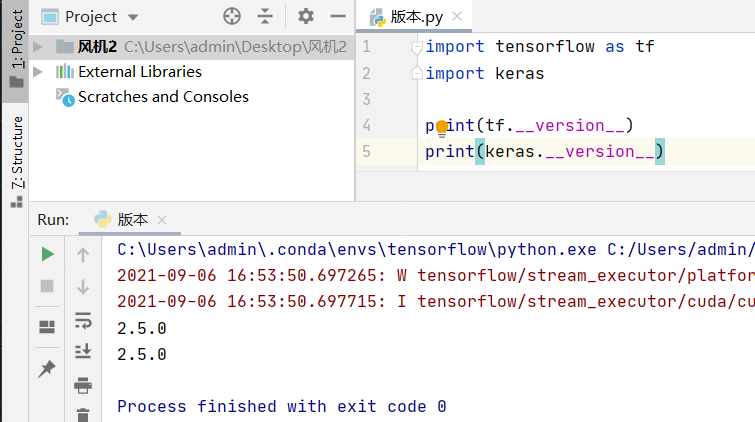使用Keras进行LSTM实战
安装依赖
本项目采用Anaconda构建虚拟环境,配置如下:
- python 3.6(64 bit)
- tensorflow 2.5.0
- keras 2.5.0
注意版本一定不能互相冲突,详情查看:https://docs.floydhub.com/guides/environments/

实战模板
1
2
3
4
5
6
7
8
9
10
11
12
13
14
15
16
17
18
19
20
21
22
23
24
25
26
27
28
29
30
31
32
33
34
35
36
37
38
39
40
41
42
43
44
45
46
47
48
49
50
51
52
53
54
55
56
57
58
59
60
61
62
63
64
65
66
67
68
69
70
71
72
73
74
75
76
77
78
79
80
81
82
83
84
85
86
87
88
89
90
91
92
93
94
95
96
97
98
99
100
101
102
103
104
105
106
107
108
109
110
111
112
113
114
115
116
117
118from math import sqrt
from numpy import concatenate
from pandas import read_csv
from pandas import DataFrame
from pandas import concat
from matplotlib import pyplot
from sklearn.preprocessing import MinMaxScaler
from sklearn.metrics import mean_squared_error
from keras.models import Sequential,load_model
from keras.layers import Dense
from keras.layers import LSTM
filename='data.csv'
# convert series to supervised learning
def series_to_supervised(data, n_in=1, n_out=1, dropnan=True):
n_vars = 1 if type(data) is list else data.shape[1]
df = DataFrame(data) ####Define a table.
cols, names = list(), list() #### Define two List.
for i in range(n_in, 0, -1): ####This is a loop which is carried out from n_in to 0.
cols.append(df.shift(i)) ##### Carry out a translation on df, and append members of to cols.
names += [('var%d(t-%d)' % (j + 1, i)) for j in range(n_vars)]
# forecast sequence (t, t+1, ... t+n)
for i in range(0, n_out): #### T
cols.append(df.shift(-i))
if i == 0:
names += [('var%d(t)' % (j + 1)) for j in range(n_vars)]
else:
names += [('var%d(t+%d)' % (j + 1, i)) for j in range(n_vars)]
# put it all together
agg = concat(cols, axis=1)
agg.columns = names
# drop rows with NaN values
if dropnan:
agg.dropna(inplace=True) ###delete all NULL records.
return agg
# load dataset
dataset = read_csv(filename, header=0, index_col=0)
values = dataset.values
# ensure all data is float
values = values.astype('float32')
# normalize features
scaler = MinMaxScaler(feature_range=(0, 1))
scaled = scaler.fit_transform(values)
# frame as supervised learning
reframed = series_to_supervised(scaled, 1, 1)
# 定义参数
n_hours = 1
n_features = 50
SeperatePoint=504
TheIntervalOfSample=10
TheDimensionOfInputVector=50
TheDimensionOfOutputVector=1
ThePositionOfActivePower=23
# split into train and test sets
values = reframed.values
n_train_hours = SeperatePoint * 24 * (60//TheIntervalOfSample)
train = values[:n_train_hours, :]
test = values[n_train_hours:, :]
n_obs = n_hours * n_features
# split into input and outputs
train_X, train_y = train[:, :n_obs], train[:,-1*(TheDimensionOfInputVector-ThePositionOfActivePower)]
test_X, test_y = test[:, :n_obs], test[:, -1*(TheDimensionOfInputVector-ThePositionOfActivePower)]
# reshape input to be 3D [samples, timesteps, features]
train_X = train_X.reshape((train_X.shape[0], n_hours, n_features))
test_X = test_X.reshape((test_X.shape[0], n_hours, n_features))
# design network
model = Sequential()
model.add(LSTM(TheDimensionOfInputVector, input_shape=(train_X.shape[1], train_X.shape[2]),return_sequences=True))
model.add(LSTM(TheDimensionOfInputVector,return_sequences=False))
model.add(Dense(TheDimensionOfOutputVector,activation='tanh'))
model.compile(loss='mae', optimizer='adam', metrics=['mse'])
# fit network
history = model.fit(train_X, train_y, epochs=271, batch_size=train_X.shape[0], validation_data=(test_X, test_y), verbose=1, shuffle=False)
# plot history
pyplot.plot(history.history['loss'], label='train')
pyplot.plot(history.history['val_loss'], label='test')
pyplot.legend()
# make a prediction
yhat = model.predict(test_X,verbose=1)
test_X = test_X.reshape((test_X.shape[0], n_hours*n_features))
# invert scaling for forecast
inv_yhat = concatenate((test_X[:, :ThePositionOfActivePower], yhat), axis=1)
inv_yhat = concatenate((inv_yhat, test_X[:, -1*(TheDimensionOfInputVector-ThePositionOfActivePower-1):]), axis=1)
# invert scaling for actual
test_y = test_y.reshape((len(test_y), 1))
inv_y = concatenate((test_X[:, :ThePositionOfActivePower], test_y), axis=1)
inv_y = concatenate((inv_y, test_X[:, -1*(TheDimensionOfInputVector-ThePositionOfActivePower-1):]), axis=1)
# calculate RMSE
rmse = sqrt(mean_squared_error(inv_y, inv_yhat))
print(dataset)
print('Test RMSE: %.3f' % rmse)保存/加载模型
# 确保已经安装h5py库 model.save('Model.h5') model = load_model('Model.h5')import pickle with open(Model.pickle','wb') as f pickle.dump(model,f) with open(Model.pickle','wb') as f pickle.load(model,f)1
2
2.import joblib # value=模型名 joblib.dump(filename='LR.model',value=lr) model = joblib.load(filename="LR.model")1
2
3.
